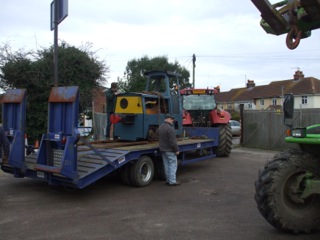
On a blustery but warm Monday December 22nd, the team arrived early and (after the usual compulsory teas) proceeded to make ready for the next stock move. James had done a series of ever-more-pessimistic method statements, each one starting: “And if that doesn’t work, we’ll do this…” but all except number one were unnecessary. Our good friend Roger Desborough arrived on time from Wenhaston, driving his tele-handler, with a friend in tow on the tractor/trailer combo., bringing the loco from its secure storage, where it has been (probably impatiently) waiting for workshop space in Southwold to open up. Then with apparent ease, he unloaded Peter Nicholson’s Motor Rail loco (which is on long-term loan to the Trust), and inserted it into the tight space left between Coach 7 and the building. There were only inches to spare, but he does know what he is doing.
Then it was only a matter of pushing the loco up the hill into the workshop, putting Coach 7 back after it, removing the temporary rail panels, and tidying the yard. It was almost as easy to do as it is to write. So that’s it, for the moment, for stock shunting, and Big Shunt II Phases 1 and 2 are complete – safely and efficiently done.
Two made-up steel panels mimicking rails arrived as well, so the loco is now resting on a shortened one. Naturally, the team was not satisfied with this, and so the entire outside was cleaned and swept, the cab was unbolted, all loose parts collected and labelled, the bonnet prepared for removal, and lots of enjoyable poking about and speculation about the various controls was also indulged in. The handbrake, after some WD40 (well – half a can, really), is now fully functional, as is the forward/reverse: such is the robust nature of the loco that the rest of the controls should be easy to free up. In general, the condition is very good indeed, with only a replacement exhaust pipe and battery tray to be built. The removal of the bolted-on superstructure is designed to open up access to the engine, hydraulic gear, and controls: the bodywork will also be easier to spruce up if it’s demounted, and the cleaning and maintenance on the engine will also be less likely to result in barked knuckles and lost nuts and spanners. Clearing up temporary rail panels and packing (for the third time, so far!)
Bernie was stencilling “DEFENSE DE FUMER” above each Coach 7 door (the coach came from the French-speaking part of Belgium, and that’s what it used to say), and generally tidying up so we are ready for our post-Christmas volunteer social event. In the end, he had to chivvy the remains of the team out of the workshop, as we would probably have carried on with the loco all day and night. Motor Rail with cab top and side panels removed – apart from the added coupling assembly, more as it would have looked when first built (Coach 7 behind)
